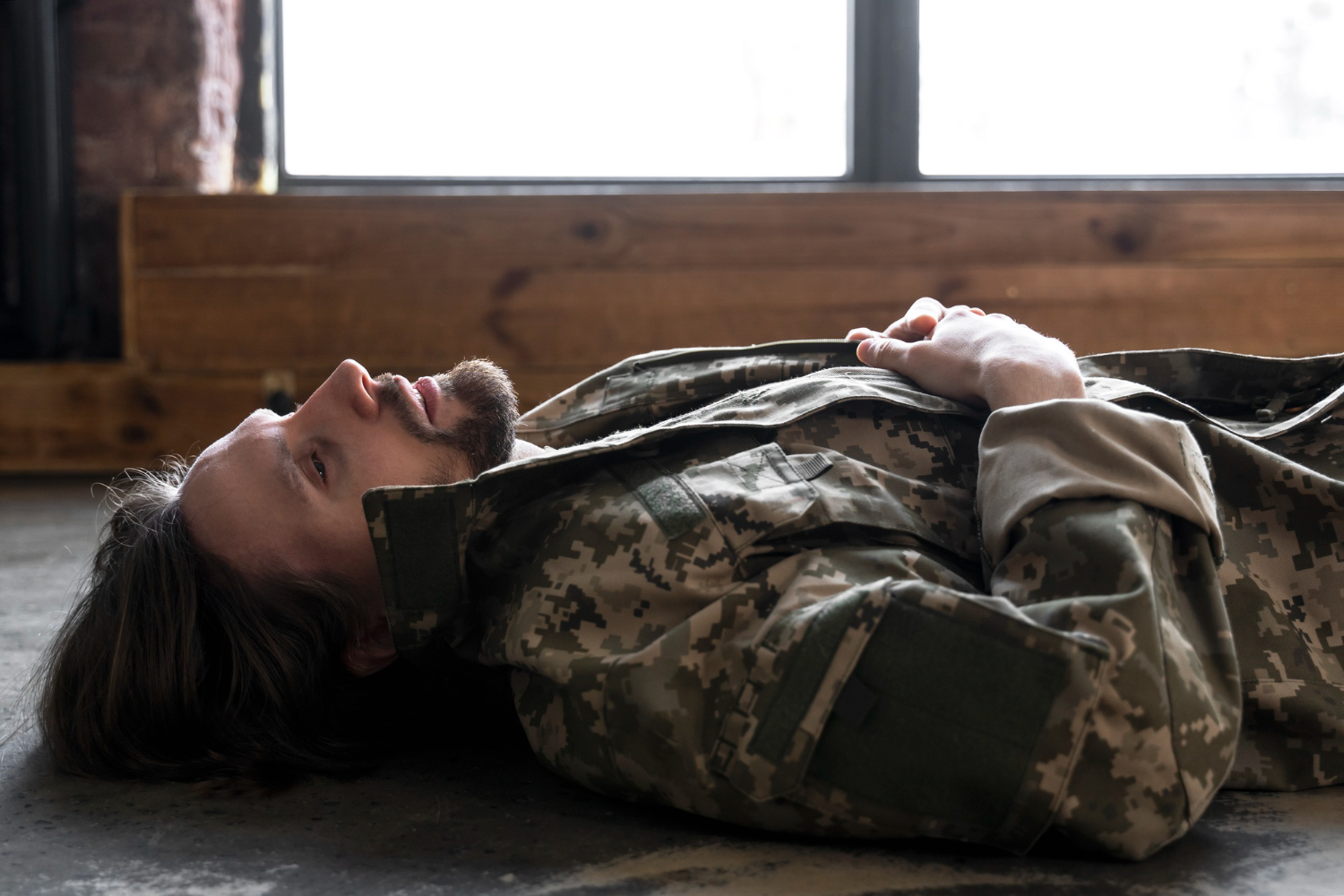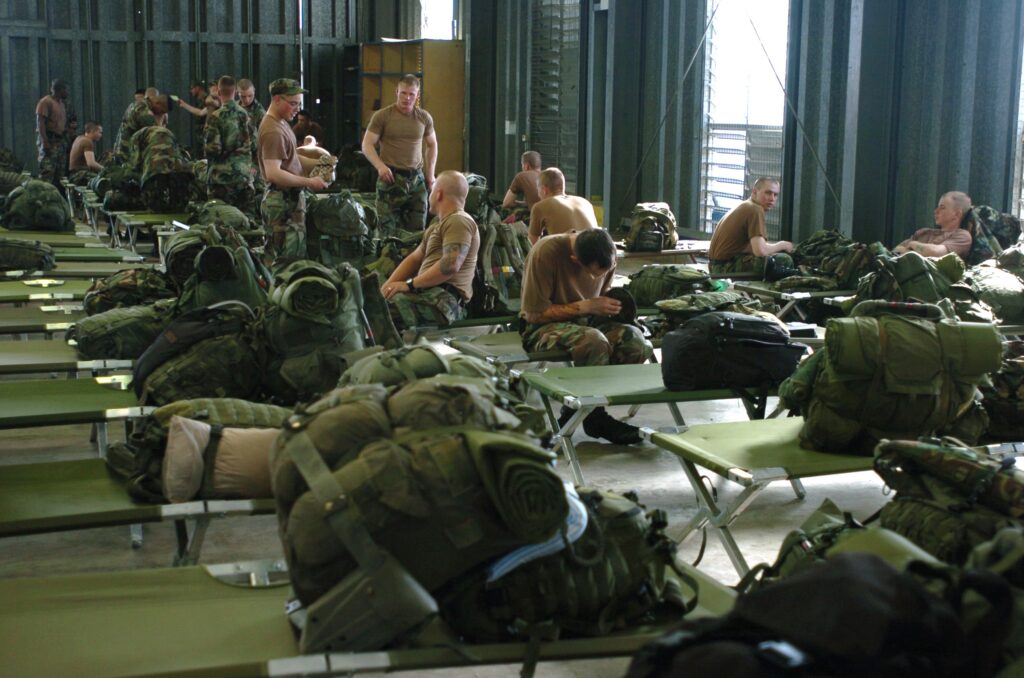Military Sleep Method Gets 96% of People Asleep in Two Minutes After Six Weeks of Practice

Your mind races at 2 AM. Questions nobody asked swim through your thoughts like uninvited guests at a party you never wanted to host. What did that text message really mean? Did you lock the front door? Why does your coworker always microwave fish in the break room?
Sleep becomes a cruel game of negotiation. You bargain with your brain, pleading for just five hours, then four, then anything that resembles rest. Meanwhile, your alarm clock mocks you with its glowing numbers, each minute bringing you closer to a day you’re unprepared to face.
Count sheep, they said. It’ll work, they promised. But sheep don’t pay your bills. Sheep don’t understand why your heart pounds when you think about tomorrow’s presentation. Sheep have never felt the weight of responsibility crushing their chest at 3 AM.
Something deeper keeps you awake. Something primal. Your nervous system believes you’re still running from predators, still hunting for survival, still fighting battles that ended hours ago. Sleep feels like surrender, and surrender feels like death.
But what if soldiers facing actual life and death situations discovered a way to sleep anywhere, anytime, under any condition? What if fighter pilots in World War II, surrounded by chaos and noise and danger, mastered the art of falling asleep in 120 seconds?
What if you could learn their secret tonight?
Sleep Deprivation Is Stealing Your Life One Restless Night at a Time
Your body keeps score. Every night you toss and turn, every morning you wake up exhausted, every afternoon you fight to keep your eyes open adds another mark against your health. Sleep debt compounds like interest on a loan you never agreed to take out.
Doctors recommend seven to nine hours per night. Most people laugh at that number. Seven hours feels like a luxury reserved for people without kids, without stress, without bills to pay. Nine hours might as well be a vacation to Mars.
But lack of sleep doesn’t just make you tired. Sleep deprivation rewires your brain in ways that seem almost designed to destroy your life. Your ability to make decisions crumbles first. You snap at people you love. You make choices that future you will regret. You become a stranger to yourself.
High level reasoning disappears next. Problems that normally take you five minutes to solve suddenly feel impossible. Your vocabulary shrinks. Words hide from you when you need them most. You sound less intelligent because your brain literally cannot access the parts that make you articulate and sharp.
Memory follows close behind. You forget appointments. You lose your keys. You walk into rooms and wonder why you’re there. People tell you things you have no recollection of hearing. Your life becomes a blur of moments you can’t quite remember.
All of this happens because your brain never gets a chance to clean itself. During sleep, your brain flushes out toxins that build up during the day. Without that nightly maintenance, those toxins accumulate. Your neurons fire slower. Your synapses weaken. Your entire nervous system operates at half capacity.
You’re not lazy. You’re not weak. You’re running a marathon on a sprained ankle, and everyone expects you to win.
How War Zones Became the Testing Ground for Perfect Sleep

Picture a fighter pilot in 1943. Enemy aircraft fill the sky. Every decision determines whether he lives or dies. Whether his crew makes it home. Whether families lose fathers, brothers, sons. Split second choices mean everything.
Now imagine that pilot hasn’t slept in 36 hours. His reflexes slow by milliseconds that feel like eternities. He misses signals. He second guesses instincts that usually keep him alive. He becomes a liability to himself and everyone depending on him.
Military commanders noticed a pattern. Sleep deprived pilots made catastrophic errors. They shot at friendly planes. They misjudged distances. They crashed during landings that should have been routine. No amount of training could compensate for exhausted brains.
Something had to change. Soldiers needed rest, but war doesn’t pause for bedtime. Battlefields don’t offer quiet rooms with blackout curtains. Gunfire and explosions don’t stop because someone needs eight hours of uninterrupted sleep.
So the Navy asked for help. They needed someone who understood human performance under pressure. Someone who knew how to push bodies and minds beyond their perceived limits. Someone who made champions out of ordinary athletes. They called Lloyd “Bud” Winter.
Winter trained Olympic athletes. He taught them how to relax when everything screamed at them to tense up. How to breathe when anxiety tried to steal their air. How to perform when the entire world watched and judged and expected perfection.
He brought those same principles to military training. If he could teach runners to stay calm before the biggest race of their lives, he could teach pilots to sleep in war zones. If he could help athletes silence their nerves, he could help soldiers silence their minds.
Winter developed a method so effective that it bordered on miraculous. A technique so simple that anyone could learn it. A practice so powerful that 96 percent of people who tried it succeeded.
Meet Lloyd Bud Winter and His 96 Percent Success Rate
Winter didn’t believe in complicated solutions. Champions succeeded because they mastered the basics, not because they discovered secret tricks. Relaxation wasn’t mystical. Sleep wasn’t mysterious. Both followed predictable patterns that anyone could learn.
His book “Relax and Win” became a manual for human performance. Athletes devoured its pages. Coaches built entire programs around its principles. And buried within those pages lived a method that would change how people thought about sleep forever.
Winter promised something audacious. Learn his technique, practice it for six weeks, and you could fall asleep in under two minutes. Anywhere. Under any condition. Even with gunfire erupting around you.
Skeptics laughed. Two minutes seemed impossible. Six weeks of practice seemed excessive. But results silenced the doubters. Pilot after pilot reported success. Soldiers in active combat zones found rest. People who hadn’t slept properly in years discovered peace.
Ninety six percent success rate meant almost everyone who committed to the practice achieved results. Not everyone succeeded immediately. Not everyone found it easy. But nearly everyone who kept trying eventually learned how to command their nervous system to sleep.
Winter understood something essential about human biology. Your brain takes cues from your body. When your muscles tense, your brain assumes danger lurks nearby. When your face scrunches, your mind believes something threatens you. When your breathing quickens, your nervous system prepares to fight or flee.
But you can reverse that signal. Make your body feel safe, and your brain believes the message. Relax your muscles, and your mind thinks the threat has passed. Slow your breathing, and your nervous system receives permission to rest.
Sleep becomes a choice instead of a struggle when you learn to speak your body’s language.
Your Face Holds 43 Muscles (And Each One Keeps You Awake)

Most people carry tension in their face without realizing it. Your jaw clenches when you concentrate. Your forehead furrows when you worry. Your eyes squeeze tight when stress builds. Forty three different muscles work together to express every emotion, hold every expression, communicate every feeling.
And every single one of those muscles can keep you awake. Your face acts as a control panel for your nervous system. When those 43 muscles relax completely, your brain receives an unmistakable message that danger has passed. Safety surrounds you. Rest becomes possible.
But most people never fully relax their face. You think you’re calm because you’re lying down. You believe you’re ready for sleep because you’re in bed. Yet your jaw stays tight. Your forehead stays tense. Your eyes squeeze shut instead of resting gently closed.
Winter made face relaxation the cornerstone of his method. He insisted students start here because nothing else works if your face stays tense. You can relax every other muscle in your body, but if your facial muscles stay engaged, your brain keeps the alert system running.
Learning to relax your face takes awareness most people have never developed. You must identify each muscle individually. Feel your jaw. Notice how it holds tension even when closed. Let it go slack. Allow your mouth to fall open slightly if it wants to.
Move to your forehead. Feel the muscles above your eyebrows. People furrow here constantly without realizing it. Smooth those muscles out. Let your eyebrows drop. Allow your forehead to become a blank canvas without expression.
Your eyes hold six muscles each. Twelve muscles total working to keep your eyelids positioned, your gaze directed, your vision focused. When you try to sleep, those muscles often stay partially engaged. You squeeze your eyes shut, thinking pressure equals relaxation. But squeezing creates more tension.
Instead, let your eyelids rest gently. Imagine your eyeballs sinking back into their sockets. Feel the muscles around your eyes going completely soft. No effort. No holding. Just release.
Your cheeks, your temples, your lips all carry micro tensions you’ve never noticed. Scan through each area. Find the tightness. Let it dissolve like sugar in warm water.
When every facial muscle finally relaxes, something shifts. Your whole nervous system recognizes the signal. If your face feels safe, you must be safe. And if you’re safe, you can sleep.
4 Steps to Fall Asleep in Two Minutes

Thinking becomes the enemy at bedtime. These techniques give your brain permission to stop analyzing and worrying. They occupy your mind just enough to prevent other thoughts from gaining traction.
Combine a fully relaxed body with a still mind for 10 seconds or longer. Your nervous system recognizes the signals safety and rest and responds by pulling you into sleep.
Step One: Get Settled Anywhere for Instant Calm
Soldiers mastered sleep in trenches. Pilots found rest in cramped cockpits. Sailors dozed on metal bunks. Your comfortable bed offers luxury they never knew.
Comfort means finding a position where your body can release control. Start wherever you are right now. Bed works best, but your office chair or the floor works too.
Lie down if possible. Flat on your back gives your body the best opportunity to relax. Side sleeping works fine too. Do not fight gravity. Stop balancing or bracing your weight with active muscles.
Get your head supported. Your neck holds incredible tension. A pillow helps. A rolled-up jacket works. Support lets your neck muscles fully release.
Close your eyes. Shutting out visual input tells your brain you are moving into rest mode. Make the environment dark if you can. Even in daylight, closed eyes start the relaxation process.
Take a breath. Let your breathing settle into its natural rhythm. Do not force anything. Just notice your breath and let it be.
Position found. Eyes closed. Breathing natural. You are ready to begin systematically releasing every muscle in your body.
Step Two: Teach Your Brain the Universal Signal for Sleep Mode
Your face goes first because face relaxation matters most. Everything else in this method builds on this step.
Begin with your jaw. Open your mouth slightly. Let your jaw hang loose like a door on broken hinges. Your tongue should feel heavy in your mouth. Your teeth should no longer touch. Gravity pulls your jaw down.
Move up to your forehead. Smooth it all out. Imagine someone’s hand gently erasing every crease, releasing every contraction.
Your temples come next. Release those small muscles along the sides of your head. Your eyes need special attention. Imagine your eyeballs sinking deeper into their sockets. Feel the muscles around your eyes going soft. Pure release.
Let your cheeks go slack. Your whole face should feel like warm wax melting. When your 43 facial muscles release completely, your brain receives the clearest possible signal that rest is permitted.
Step Three: Melt Every Muscle from Shoulders to Toes
Your shoulders carry the weight of your world. Drop them. Let both shoulders sink toward the floor. Feel them give up their job of protection.
Start with your arms. Focus on your dominant arm first. Upper arm, forearm, hand. Let all the tension drain away like water flowing downhill. Your hand should feel completely relaxed and heavy. Release your other arm using the same process.
Your neck comes next. Give it permission to stop working. Feel your neck muscles soften. Your torso needs attention too. Let your chest muscles soften. Let your belly go soft. Your back muscles can now rest. Feel your back spreading against the surface beneath you.
Move down to your hips and buttocks. Let them go heavy. Release any clenching.
Your legs deserve rest. Focus on your dominant leg first. Thigh, knee, calf, foot. Let everything release. Let your foot fall into whatever position feels natural without any muscular input. Release your other leg completely. Your whole body now feels like warm clay. Heavy. Soft. Completely relaxed.
Step Four: Empty Your Mind with Simple Visualization Tricks
Physical relaxation creates the foundation, but mental quiet seals the deal. You need to calm both.
Use one of these three techniques:
- Visualization One: Imagine a warm spring day. Picture yourself lying in the bottom of a canoe on a calm lake. Blue sky stretches above you. Hold this peaceful image for at least 10 seconds.
- Visualization Two: Picture yourself in a large black velvet hammock. Everywhere you look, you see nothing but black. Hold this stillness for 10 seconds.
- Visualization Three: Repeat a simple phrase to yourself: “Don’t think. Don’t think. Don’t think.” Let it become a mantra that pushes other thoughts aside. Repeat for at least 10 seconds.
Six Weeks of Practice Separates You from Two Minute Sleep

Winter never promised instant results. Magic pills don’t exist. Quick fixes fail. Real skill requires practice. Pilots who mastered his method needed six weeks of consistent effort.
Six weeks sounds like forever when you’re desperate for sleep tonight. But six weeks passes whether you practice or not. You can spend those six weeks still struggling, still tossing and turning, still losing sleep. Or you can spend them learning a skill that changes the rest of your life.
Start tonight. Lie down 10 minutes earlier than usual. Run through the complete method. Relax your face. Release your body. Still your mind. Don’t expect perfection. Don’t demand immediate sleep. Just practice the steps.
Tomorrow night, practice again. And the next night. And the night after that. Some nights you’ll feel it working. Other nights you’ll wonder if you’re wasting your time. Keep going.
Week one feels awkward. You forget steps. You can’t remember which muscle comes next. Your mind wanders constantly. You fall asleep before finishing, or you finish without falling asleep. Both outcomes happen. Both are fine. You’re learning.
Week two feels slightly easier. You remember the sequence better. You find tension you missed before. You notice when your jaw clenches again. You catch yourself thinking when you meant to be visualizing. Progress shows up in small ways.
Week three might feel frustrating. You seem to move backwards. Some nights work worse than week one. Your brain rebels against the practice. You question whether this method works at all. Push through. Regression is part of learning any new skill.
Week four brings breakthroughs. One night, you fall asleep faster than usual. Maybe not two minutes, but noticeably quicker. You wake up feeling different. Something shifted.
Week five builds consistency. More nights work than don’t. You start to trust the process. Your body begins responding automatically to the cues. Relaxation comes easier. Your mind quiets faster.
Week six delivers results. Most nights now, sleep comes quickly. You might not hit two minutes every time, but you’re close. You’ve trained your nervous system to recognize the pattern. Practice becomes habit. Habit becomes skill. Skill becomes your new normal.
Some people need longer than six weeks. Eight weeks. Ten weeks. What matters isn’t the timeline. What matters is consistency. Practice every single night. Even nights you feel tired enough to fall asleep without help. Even nights you’re tempted to skip it. Build the habit so deep that your body starts the process automatically when you lie down.
Why Most People Fail at This Method (And How to Beat the Odds)

Ninety six percent success rate means four percent fail. You need to understand why failure happens so you can avoid it.
Some people skip the face relaxation. They think it sounds silly or unnecessary. But face relaxation is the foundation. Skip this step, and nothing else works.
Others practice inconsistently. They try it one night, forget for three nights, try again, then skip a week. Your nervous system needs consistent repetition to learn new patterns. Practice every single night.
Many people give up too soon. Week three feels hard, so they quit. But week three is exactly when they should push harder. Difficulty often signals imminent breakthrough.
Caffeine after 2 PM sabotages even perfect practice. Coffee at 4 PM means you’re still wired at midnight. Your relaxation technique can’t fight against stimulants actively working to keep you awake.
Screen time before bed floods your brain with blue light that suppresses melatonin. Your brain thinks it’s still daytime. Put the phone away at least an hour before bed.
Room environment matters. Too hot, too cold, too noisy, or too bright all prevent sleep. Fix your environment before blaming the technique.
If you practice consistently for six weeks and still can’t sleep, medical conditions might be interfering. Sleep apnea, restless leg syndrome, chronic pain, anxiety disorders, or depression all require professional treatment. No technique replaces proper healthcare when underlying conditions exist.
Sleep Like Your Life Depends on It Because It Does
Your life doesn’t pause while you’re awake. Every moment demands something from you. Every hour asks you to perform, produce, provide. You give and give and give until nothing remains, and then you’re expected to give more.
Sleep isn’t a luxury you earn after everything else is finished. Sleep is the foundation that makes everything else possible. Without adequate rest, you can’t think clearly, feel balanced, work effectively, love fully, or live well.
Fighter pilots in World War II learned this truth when lives depended on their performance. Soldiers in combat zones discovered it when split second decisions meant survival or death. Winter taught them a method that worked under the worst possible conditions.
You face different battles, but they’re battles nonetheless. You fight traffic every morning. You navigate workplace politics every day. You manage family dynamics every evening. You carry stress and worry and responsibility with every breath.
You deserve rest. Not someday when life calms down. Not eventually when you’ve achieved enough. Not later when you’ve earned it. Right now. Tonight. Every night.
Winter’s method offers you a path. Forty three facial muscles released. Your whole body melted into softness. Your mind stilled through visualization. Ten seconds of complete quiet. And then sleep.
You could be one of them. You should be one of them. You will be one of them if you start tonight and refuse to quit. Your life depends on sleep. Your sleep depends on practice. Your practice starts now. Close your eyes. Relax your face. Release your body. Still your mind. And let go.
Loading...

